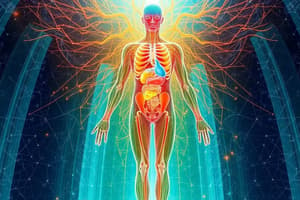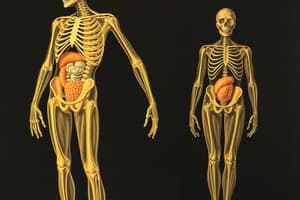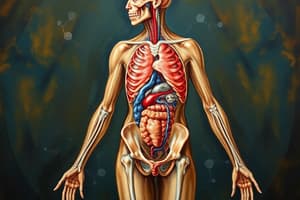Podcast
Questions and Answers
What is the main function of the circulatory system?
What is the main function of the circulatory system?
The circulatory system transports oxygen and nutrients throughout the body and helps remove waste products.
What organs or parts make up the circulatory system?
What organs or parts make up the circulatory system?
The circulatory system includes the heart, blood vessels (arteries, veins, capillaries), and blood.
What is the function of the heart in the circulatory system?
What is the function of the heart in the circulatory system?
The heart pumps blood throughout the body.
What are the three main types of blood vessels in the circulatory system?
What are the three main types of blood vessels in the circulatory system?
Which blood vessel carries oxygen-rich blood away from the heart?
Which blood vessel carries oxygen-rich blood away from the heart?
Which blood vessel carries oxygen-poor blood back to the heart?
Which blood vessel carries oxygen-poor blood back to the heart?
What is the function of capillaries in the circulatory system?
What is the function of capillaries in the circulatory system?
What are the main components of blood?
What are the main components of blood?
Which component of blood is responsible for transporting oxygen?
Which component of blood is responsible for transporting oxygen?
Which component of blood helps fight infection?
Which component of blood helps fight infection?
Which component of blood helps clot blood?
Which component of blood helps clot blood?
What is the function of the digestive system?
What is the function of the digestive system?
What are the major organs of the digestive system?
What are the major organs of the digestive system?
What is the function of the esophagus in the digestive system?
What is the function of the esophagus in the digestive system?
What is the function of the stomach in the digestive system?
What is the function of the stomach in the digestive system?
What is the function of the small intestine in the digestive system?
What is the function of the small intestine in the digestive system?
What is the function of the respiratory system?
What is the function of the respiratory system?
What are the major structures of the respiratory system?
What are the major structures of the respiratory system?
What are the tiny air sacs in the lungs called?
What are the tiny air sacs in the lungs called?
How does gas exchange occur in the lungs?
How does gas exchange occur in the lungs?
What is the role of the diaphragm in breathing?
What is the role of the diaphragm in breathing?
What is the main function of the kidneys in the excretory system?
What is the main function of the kidneys in the excretory system?
What is the function of the muscular system?
What is the function of the muscular system?
What are the three main types of muscle tissue?
What are the three main types of muscle tissue?
Which type of muscle tissue is responsible for voluntary movement?
Which type of muscle tissue is responsible for voluntary movement?
Which type of muscle tissue is found in the digestive tract and blood vessels?
Which type of muscle tissue is found in the digestive tract and blood vessels?
Which type of muscle tissue is found in the heart?
Which type of muscle tissue is found in the heart?
How do skeletal muscles work in pairs?
How do skeletal muscles work in pairs?
What is the function of the skeletal system?
What is the function of the skeletal system?
What are the two main components of the skeletal system?
What are the two main components of the skeletal system?
What is the function of the reproductive system?
What is the function of the reproductive system?
What are the primary sex cells produced by the male and female reproductive systems?
What are the primary sex cells produced by the male and female reproductive systems?
What is the function of the nervous system?
What is the function of the nervous system?
What are the major structures of the nervous system?
What are the major structures of the nervous system?
What is the basic cell type of the nervous system?
What is the basic cell type of the nervous system?
What are the two main divisions of the nervous system?
What are the two main divisions of the nervous system?
What is the function of the endocrine system?
What is the function of the endocrine system?
What are the major glands of the endocrine system?
What are the major glands of the endocrine system?
What is the function of the lymphatic system?
What is the function of the lymphatic system?
What is the function of the integumentary system?
What is the function of the integumentary system?
Flashcards
Human Body Organization
Human Body Organization
The human body is organized into organ systems, which are composed of organs, tissues, and cells, working together to maintain homeostasis.
Organ Systems
Organ Systems
Groups of organs that work together to perform a specific function in the body.
Circulatory System Function
Circulatory System Function
Transports oxygen and nutrients throughout the body, and removes waste products.
Circulatory System Organs
Circulatory System Organs
Signup and view all the flashcards
Arteries
Arteries
Signup and view all the flashcards
Veins
Veins
Signup and view all the flashcards
Capillaries
Capillaries
Signup and view all the flashcards
Blood Components
Blood Components
Signup and view all the flashcards
Digestion
Digestion
Signup and view all the flashcards
Digestive System Function
Digestive System Function
Signup and view all the flashcards
Digestive Organs
Digestive Organs
Signup and view all the flashcards
Esophagus
Esophagus
Signup and view all the flashcards
Small Intestine
Small Intestine
Signup and view all the flashcards
Large Intestine Function
Large Intestine Function
Signup and view all the flashcards
Respiratory System
Respiratory System
Signup and view all the flashcards
Gas Exchange
Gas Exchange
Signup and view all the flashcards
Diffusion
Diffusion
Signup and view all the flashcards
Alveoli
Alveoli
Signup and view all the flashcards
Nutrients
Nutrients
Signup and view all the flashcards
Study Notes
Human Body Systems
- The human body is composed of organ systems
- Organ systems are composed of organs
- Organs are composed of tissues
- Tissues are composed of cells
Learning Objectives
- Describe the general and unique characteristics of different organ systems in representative animals
- Analyze and appreciate the functional relationships of different organ systems in ensuring animal survival
Eleven Body Systems
- Nervous System
- Endocrine System
- Lymphatic System
- Circulatory System
- Respiratory System
- Digestive System
- Excretory System
- Skeletal System
- Muscular System
- Integumentary System
- Reproductive System
Circulatory System
- Transports oxygen and nutrients around the body
- Helps get rid of wastes
- Composed of arteries, veins, heart, and blood
The Heart
- Pumps blood throughout the body
Types Of Blood Vessels
Arteries
- Move blood away from the heart
- Have thick, elastic walls made of smooth muscles
- Connected to ventricles in the heart
Veins
- Move blood toward the heart
- Have one-way valves
- Squeezed by skeletal muscles
- Carry oxygen-poor blood with waste materials
Capillaries
-
Microscopic blood vessels
-
Connect arteries to veins
-
Walls are only one cell thick
-
Exchange nutrients and oxygen from blood to body cells
-
Arteries carry blood away from the heart
-
Veins carry blood to the heart
-
Capillaries connect arteries and veins, facilitating the exchange of materials
Blood
- Type of cell that carries oxygen
- Composed of plasma, platelets, white blood cells, and red blood cells
- Plasma: 55% of blood, contains water, ions, proteins, nutrients, wastes, and gases
- Platelets (1%): help clot blood
- White blood cells (1%): fight infection
- Red blood cells (44%): transport oxygen
Digestive System Function
- Digestion breaks down food into small molecules for absorption and use by the body
Nutrients
- Substances in food that provide energy and material for cell development, growth, and repair
Major Organs (Digestive System)
- Mouth
- Esophagus
- Stomach
- Small intestine
- Large intestine
Parts of the Digestive System
Esophagus
- Muscular tube connecting the throat to the stomach
- Moves food down by squeezing (peristalsis)
Stomach
- Muscular bag where chemical and mechanical digestion continue
- Food stays ~4 hours, changes to chyme
Small Intestine
- Tube (nearly 7 meters long) where digestive juices from the liver and pancreas are added
- Villi absorb small nutrient molecules
- All chemical and physical digestion ends here
Large Intestine
- Absorbs water from undigested food
- Unabsorbed materials become more solid
- Stores solid wastes (feces)
- Rectum: where solid wastes (feces) are stored
- Anus: release solid wastes (feces)
Respiratory System
- Major Structures: lungs, nose, mouth, trachea
- Functions: moves air into and out of lungs, controls gas exchange between blood and lungs
- Gas exchange in the lungs occurs through diffusion
- High concentration of oxygen moves from lungs to blood
- Carbon dioxide moves from blood to lungs
Excretory System
- Removes cellular wastes from blood and the body
- Major Structures: kidneys, urinary bladder, ureters, urethra, skin, lungs
Muscular System
- Function: Movement
- Major Muscle Types:
- Skeletal: attached to bones for voluntary actions
- Smooth: found in the digestive tract and blood vessels to move food and blood (involuntary)
- Cardiac: heart muscle cells (involuntary)
- Skeletal muscles work in opposing pairs
- Muscles can only pull; they cannot push
- Energy is stored in muscles in a chemical called ATP
- Lactic acid is released when muscles are overworked
Skeletal System
- Major Structures: bones and joints
- Functions: protects organs, shapes and supports the body, interacts with skeletal muscles (allows movement), produces blood cells in bone marrow, stores minerals (calcium and phosphorus)
Reproductive System
- Functions: produces gametes (eggs and sperm), allows for the continuation of the species
- Major Structures: ovaries, uterus, and testes and penis
Lymphatic System
- An organ system that is a part of the immune system and is complementary to the circulatory system
- It consists of lymphatic vessels, lymph nodes, lymphoid organs, lymphatic tissue, and lymph
Integumentary System
- Composed of the skin and its appendages
- Acts as a physical barrier between the external and internal environments protecting and maintaining the animal's body.
Endocrine System
- Regulates body activities (temperature, metabolism, development, and reproduction)
- Maintains homeostasis
- Regulates other organ systems
- Major Glands: hypothalamus, pituitary, pancreas, adrenal, thyroid, testes, ovaries
Nervous System
- Major Structures: brain, spinal chord, nerves, sensory organs
- Functions: regulate behavior, maintains homeostasis, regulate other organ systems, controls sensory and motor functions
- Communication center of the body
Studying That Suits You
Use AI to generate personalized quizzes and flashcards to suit your learning preferences.




